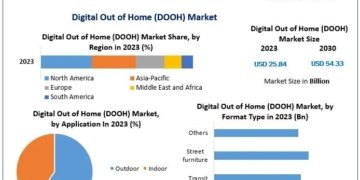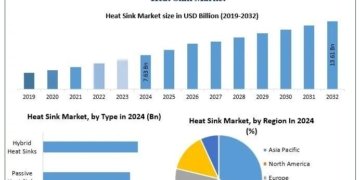The Microscope Software Market is valued at USD 1.21 billion in 2024, and is expected to reach USD 3.02 billion by 2034, growing at a CAGR of 9.5% between 2025 and 2034.
Microscope software enhances usability and performance by controlling microscope hardware, managing workflows, and enabling image analysis, annotation, 3D reconstruction, and automated quantification. As microscopy applications become more complex, especially in fluorescence, electron, and confocal microscopy, software plays a vital role in turning raw data into usable insights.
Key market drivers include digital pathology, remote collaboration, and AI-enhanced imaging workflows-catalyzing adoption in both research and clinical applications.
Download Full PDF Sample Copy of Market Report @ https://exactitudeconsultancy.com/request-sample/68249
Key Market Drivers
• Growth of Digital Pathology: As hospitals and labs shift from physical slides to digital scans, microscope software facilitates scanning, archiving, and sharing.
• Integration of AI and Deep Learning: Automated feature recognition, segmentation, and anomaly detection enhance efficiency in both academic and clinical research.
• Demand for High-Throughput Imaging: Advanced software enables batch processing, fast image acquisition, and streamlined analysis in pharma and biotech workflows.
• Microscopy-as-a-Service Models: Cloud-based microscope software allows remote operation, reducing the need for in-house infrastructure.
• Advances in Imaging Modalities: Software supports integration of multiple techniques like phase-contrast, confocal, SEM, TEM, and fluorescence into a single workflow.
Key Restraints and Challenges
• High Cost of Premium Software Licenses: Advanced modules for AI, 3D rendering, or high-content screening come with high upfront or subscription costs.
• Integration with Legacy Systems: Older microscope hardware may be incompatible with modern software suites without adapters or custom APIs.
• Complex User Interfaces: Learning curves for advanced analytical tools can limit adoption in academic institutions or small labs.
• Data Privacy Concerns: Cloud-based software solutions raise questions around data sovereignty, especially in clinical and regulatory environments.
• Low Penetration in Developing Regions: Many labs in emerging economies still rely on manual processes due to budget constraints or lack of digital training.
Opportunities & Trends
• Cloud Collaboration Platforms: Remote access and sharing of microscopy images are enabling virtual teamwork, especially in global research projects.
• 3D Visualization and VR Integration: New tools allow rendering of volumetric datasets for better understanding of structures in cell biology and materials.
• Cross-Modality Integration: Seamless analysis across brightfield, fluorescence, and scanning probe microscopy in a single interface is becoming possible.
• Digital Education Tools: Schools and universities are adopting microscope software for remote learning, image annotation, and virtual labs.
• Automated Workflow Creation: Drag-and-drop workflow builders allow users to set up automated acquisition, labeling, and analysis sequences.
Market Segmentation
By Software Type
• Image Analysis Software
• Control & Acquisition Software
• 3D Reconstruction Software
• Data Management & Sharing Platforms
• AI & Machine Learning Modules
• Custom Plug-ins and Open-Source Integrations
By Microscopy Type Supported
• Optical Microscopy
• Electron Microscopy (SEM, TEM)
• Fluorescence Microscopy
• Scanning Probe Microscopy
• Confocal & Super-Resolution Microscopy
By Application
• Life Sciences & Cell Biology
• Pathology & Diagnostics
• Materials Science
• Semiconductor & Nanotech Research
• Pharmaceutical R&D
• Forensics & Security
• Educational & Academic Research
By End-User
• Academic & Research Institutes
• Hospitals & Diagnostic Centers
• Biotechnology & Pharmaceutical Companies
• Industrial & Manufacturing Laboratories
• Government and Defense Laboratories
Explore Full Report here: https://exactitudeconsultancy.com/reports/68249/microscope-software-market
Regional Insights
North America
North America leads the microscope software market with a market share of 38% in 2024, thanks to its early adoption of digital pathology, advanced research infrastructure, and strong life sciences industry presence. The U.S. remains the core hub for innovation in AI-integrated imaging and clinical research tools.
Europe
Europe holds around 30% share, supported by academic research, public healthcare digitization programs, and the rise of EU-funded biotechnology projects. Countries like Germany, the UK, and the Netherlands are investing in next-gen imaging platforms.
Asia Pacific
Asia Pacific is emerging rapidly with a CAGR of 10.3%, led by expanding biotech clusters in China, India, South Korea, and Japan. The surge in university funding and smart hospital initiatives is driving regional growth.
Latin America & MEA
These regions are witnessing early-stage adoption driven by improvements in healthcare access, medical education, and government support for laboratory infrastructure.
Competitive Landscape
The microscope software ecosystem includes global microscopy hardware giants, specialized software developers, and open-source contributors. Key strategies include AI-enhancement, cloud platform integration, user experience design, and cross-modality compatibility.
Key Players Include:
• Carl Zeiss AG: Offers powerful imaging software like ZEN for fluorescence, confocal, and electron microscopy.
• Olympus Corporation: Provides OLYVIA and cellSens suites for life sciences, industrial, and education markets.
• Nikon Corporation: Delivers NIS-Elements software known for its intuitive interface and high-content screening tools.
• Leica Microsystems: Combines imaging hardware with LAS X platform for seamless workflows in biomedical and industrial research.
• Oxford Instruments: Develops AZtec software supporting SEM, EDS, and electron backscatter diffraction (EBSD) analysis.
• Thermo Fisher Scientific: Integrates AI with their Amira and Avizo suites for 3D visualization and simulation.
• Danaher Corporation (through Molecular Devices & Cytiva): Offers robust platforms for live-cell imaging and high-throughput analysis.
Get Your Exclusive Offer with up to 10% Discount : https://exactitudeconsultancy.com/checkout/?currency=USD&type=single_user_license&report_id=68249
Recent Developments (Q1-Q2, 2025)
1. March 2025 – Carl Zeiss AG: Launched ZEN Blue 4.0 with embedded AI tools for live cell tracking and deep neural network image enhancement.
2. February 2025 – Nikon Corporation: Released a cloud-compatible update to NIS-Elements, enabling remote access, real-time collaboration, and secure storage.
3. April 2025 – Leica Microsystems: Introduced smart automation workflows in LAS X for histopathology, reducing slide analysis time by 45%.
4. January 2025 – Oxford Instruments: Expanded AZtec platform with ML-based feature recognition for improved materials analysis.
5. March 2025 – Thermo Fisher Scientific: Partnered with a biotech firm to embed 3D volumetric visualization modules into clinical oncology workflows.
Events and Implications
• AI Democratization: Advanced image classification and segmentation tools are now accessible to smaller labs due to modular, subscription-based pricing.
• Smart Pathology Labs: Whole-slide imaging and auto-analysis are transforming diagnostics in hospitals and telemedicine setups.
• VR and 3D Imaging Surge: Educational institutions and research labs are adopting VR-based 3D microscopy for immersive learning and visualization.
• Open-Source Integration: Open plugins and Python-based APIs are enabling custom workflows in high-throughput academic environments.
• Decentralized Research Models: Cloud-native platforms are supporting real-time, cross-border scientific collaboration on microscopy datasets.
Conclusion
The Microscope Software Market is fast becoming the nerve center of next-generation imaging. With a projected value of USD 3.02 billion by 2034 and a strong CAGR of 9.5%, it is playing a crucial role in biomedical innovation, materials discovery, and education modernization.
North America and Europe continue to lead innovation, while Asia Pacific emerges as the fastest-growing region. Industry players that deliver modular, AI-enabled, and cloud-integrated software platforms will be best positioned to capture long-term growth.
As digital microscopy expands into diagnostics, drug discovery, education, and forensics, software-driven imaging will redefine how the world sees science-literally and virtually.
This report is also available in the following languages : Japanese (顕微鏡ソフトウェア市場), Korean (현미경 소프트웨어 시장), Chinese (显微镜软件市场), French (Marché des logiciels de microscope), German (Markt für Mikroskopsoftware), and Italian (Mercato del software per microscopi), etc.
Request for a sample of this research report at (Use Corporate Mail ID for Quick Response) @ https://exactitudeconsultancy.com/reports/68249/microscope-software-market#request-a-sample
Our More Reports:
Indonesia Lubricants Market
https://exactitudeconsultancy.com/reports/67586/indonesia-lubricants-market
Radar Absorbing Paint Market
https://exactitudeconsultancy.com/reports/67584/radar-absorbing-paint-market
Container as a Service (CaaS) Market
https://exactitudeconsultancy.com/reports/67582/container-as-a-service-caas-market
About Us
Exactitude Consultancy is a market research & consulting services firm which helps its client to address their most pressing strategic and business challenges. Our market research helps clients to address critical business challenges and also helps make optimized business decisions with our fact-based research insights, market intelligence, and accurate data.
https://bulletin.exactitudeconsultancy.com/
https://www.thehealthanalytics.com/
https://www.marketintelligencedata.com/
https://www.marketinsightsreports.com/
https://exactitudeconsultancy.com/
Connect Us:
Irfan Tamboli
PHONE NUMBER +1 (704) 266-3234
EMAIL ADDRESS: sales@exactitudeconsultancy.com
This release was published on openPR.














